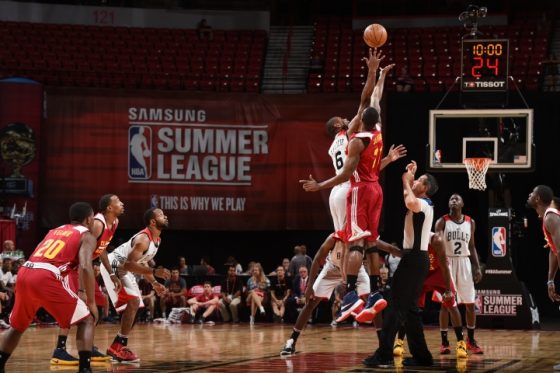
The Wood Shop: Kyrie Learned Himself Some Defense
2016-07-19
During the Finals, a lot of talk was focused on the quality of Kyrie Irving‘s defense. Kyrie is typically not a great defender. He gets stuck to screens. He will watch the jumbotron instead of his man if his man doesn’t have the ball. What’s more, he has a bad habit of letting a guy blow by him and then blaming the help defense for not rotating quickly enough.
Kyrie is by no means a defensive savant, but the Finals showed the world that, when he puts his mind to it, he has the ability to be a capable defender (and, perhaps, even more).
Defending the Pick and Roll
During the Eastern Conference Finals, Toronto thought they had cracked the code in how to beat the Cavs. They made Kevin Love and Irving a part of almost every single defensive action. As Zach Lowe said during that series, it was a solid game plan:
But Irving and Love have been the central players in Cleveland’s worst breakdowns. Opponents in the playoffs have scored 1.09 points per chance when they involve those two as the primary pick-and-roll defenders in a play that leads directly to a shot attempt, drawn foul or turnover, per SportVU data provided to ESPN.com. That would have ranked last by a mile among 119 two-man combos that defended at least 250 pick-and-rolls in the regular season, per that SportVU data set.
Zoom out to include any trip that features a pick-and-roll targeting Irving and Love at any time, and the number gets worse: a hideous 1.207 points allowed per possession, stingier than only one of those 119 duos — the Jrue Holiday/Ryan Anderson pairing in New Orleans.
Irving didn’t let that info demoralize him in the Finals. He figured out that if you stay close to your man and anticipate what’s coming, you have a really good chance of not getting burned by screens.
In the above play Klay Thompson comes to set a screen to free up Stephen Curry. Klay isn’t the most sneaky screen setter so his arms are in position to block and Kyrie sees that. Usually Kyrie would get glued to that screen and earn the name “Fly Paper” Ky. Instead, he stutter steps around it and contests Curry’s 3-pointer.
Irving also showed the ability to anticipate and fight past screens numerous times in the series.
In that play, Andrew Bogut comes and sets a quick screen on the left for Curry to get free into the paint. Love does a good job of stopping Curry from using it by cutting off his path to the middle. However, notice Irving’s arm pushing past Bogut’s body to keep Curry off balance. It’s keeping him from whipping a pass to the rolling Bogut. Notice how Bogut shuffles his feet once the screen is set to try and make more space. Kyrie still doesn’t get caught on it.
A lot of Irving’s effectiveness covering the pick and roll came from communication. Many times during the season, Irving would switch when covering a pick and roll and fail to communicate when he was going to switch back. This resulted in two guys on one man with a free guy going to the hoop. Or, just two defenders in limbo trying to play defense on two guys at once.
In this play, Love’s man screens Irving. The play is designed to get Curry towards the middle of the floor. Love shoots up high to prevent Curry from turning towards the open area. Irving goes onto Love’s man. However, the two switch back after one second. It’s seamless with both guys crossing halfway while switching onto their original assignments. I can almost hear the two yelling, “go back.”
Irving showed the ability to communicate when he had to execute traps on Curry early on in the series.
Here, Bogut sets a slip screen towards the middle for Curry, which Irving easily avoids. Love has pushed into Bogut’s side the entire time to make sure he can slide off and stop Curry with a moment’s notice. This has also pushed the play well past Curry’s super-automatic-three range. Since Bogut slips to the paint before making contact with Kyrie, Kyrie is right on Steph’s hip. He stays there. Love is already there, so the pair traps Curry. There is no hesitation at all, which makes it work quite well. Curry has a myriad of arms bugging him. The baby faced assassin makes a weak bounce pass which keeps the Warriors from capitalizing on the 4-on-3 play. The Cavs rotate fast enough to prevent any holes from opening up.
It’s Really About Effort
If we’re looking purely at statistics, Irving wasn’t a better defender in the post season. As far as influencing shots goes, he actually made guys shoot .6% worse than their average in the regular season. Not impressive, but still a sign that he wasn’t terrible. In the playoffs, guys were shooting 7.1% better with Uncle Drew on them, and in the Finals, guys were shooting 8% better. Yet, I would still say Irving played some of the best defense of his career in that seven game battle. He showed he cared. There weren’t very many easy buckets for Stephen Curry.
Look at that play. Irving stops Curry from penetrating despite some fancy handles. Then Curry gives the ball up and tries to run Irving off a LeBron own-team screen. Irving follows Curry though, and when Curry gets the ball back, Irving starts getting his hands into his jersey and drives him straight into some rim protection by Love. Irving steals the dump off pass and ultimately helps LBJ throw down a vicious alley oop.
The stats back up the fact that Irving hassled Curry better than most do. With Irving off the court in the Finals, Curry was a strong +18.4/36 minutes. With Irving on the court, Curry couldn’t do anything. He was –2.5/36 minutes. That’s not a typo. I won’t be calling for Irving to be on the all defensive team any time soon but, at least in the 2016 Finals, he was no longer a joke.



This is the greatest video in the history of the internet.
https://vimeo.com/175307997
Epic. Awesome. Video.
Amazing what the kids can accomplish these days…
Yep
Nice!
I love that he picks up a pipe.
And the screen on top says “you got the pipe”
Wow… how did Mime Killer get $5M for two years? No wonder guys like Ray Allen and Rip Hamilton want to come back and cash in one more time… I guess every salary cap has it’s salary floor…
One month ago today… THE CAVS WON THE CHAMPIONSHIP!
(How’s that for celebrating, Cols?)
A little reminder of how they did it:
https://youtu.be/3hp7NfhmGfA?t=484
Thank you phil i have been rewatching all the games on league pass but they no just recently took down the finals i was hoping they would leave the games on league pass all summer i can watch especially that game 7 or game 5 a hundred times or game 6 or game 3 haha we are champs ?
While reading this article, for some reason, I had one of those “Holy #%*+!, the Cavs won the Title!” moments. That felt good.
Great work David! Those numbers of Kyrie’s effect on Steph are eye opening
Speaking of Kyrie:
https://www.youtube.com/watch?v=DqvPNB37XV0
Even more so next year, with KD joining the Golden State Bandwaggoners, this team will need Irving to commit to defense. I was wary that he wasn’t fully back from injury when his defense was so atrocious last year. It really took a step back. But he rallied. Let’s hope they practice it all year so their communication on D become automatic.
I hope he can play average defense this season but if he amps it up in playoffs it doesnt really matter how he plays d in the regular season
Yep. Irving owned Curry all Finals. So much for the trade Irving crowd around here. I still haven’t seen them say they were wrong.
http://treasure.diylol.com/uploads/post/image/430043/resized_the-most-interesting-man-in-the-world-meme-generator-i-don-t-always-troll-but-when-i-do-i-keep-it-subtle-11faa6.jpg
Hey as much as it pains everyone, most of Cols crazy predictions came to fruition. “Leb” was awesome and Kyrie suddenly was a key cog and important contributor to our 1st Championship!!!
Although Kyrie got it done in the end the alternative scenariowith a trade for Chris Paul probably would have also ended in a championship too, but we will never know. Lebron was the necessary but not sufficient factor while Kyrie was sufficient but not necessary.
They were wrong.
As Cols would say: “That’s AWESOME!”.